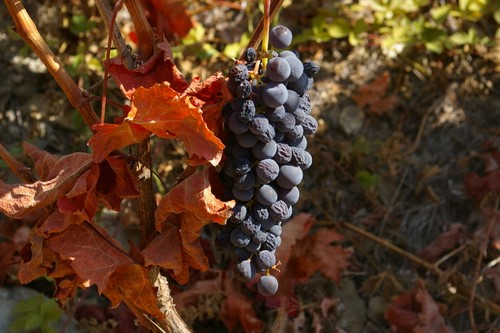I’m listening to some of the reports coming out of Bordeaux with alarm. The 2009 vintage has a dark side: high alcohol. The wine of one famous chateau weighs in at a heady 15.6% alcohol. In Bordeaux? This is a region that used to make great wines at around 12% alcohol. Not any more.
There are some misconceptions about why high alcohol can be problematic. It’s not the fact that the wine is more intoxicating – after all, you can simply drink less of it. Nor is it impossible to find delicious wines at high alcohol levels (for example, I’m a fan of Port, Sherry and Madeira, which have considerably higher alcohols than most table wines).
I think there are two (related) problems with high alcohol.
The first is that alcohol affects the perception of other components of the wine. I’m not talking here about the effects of alcohol on the taster, but rather that as the alcohol level rises, it changes the way that the fruit, body, sweetness and structure of the wine is perceived, as well as altering the aromas.
This is demonstrated clearly in sweet spot tastings, where the same wine has its alcohol levels adjusted by reverse osmosis or spinning cone. There are dramatic differences between the same wine at, say, 14.5% alcohol and 12% alcohol. These sorts of experiments show that alcohol is having a considerable effect on the way the other components of the wine are perceived. At lower alcohol levels the wine tastes much more savoury, with better definition of fruit and clearer aromatics.
The other problem with high alcohol levels is that these are usually achieved by picking the grapes late. In some cases, too late. This is a stylistic choice.
In the past Bordeaux wines frequently used to have a little greenness to them in their youth. There’s good greenness and bad greenness, and sometimes good greenness sets the wine up for long, elegant ageing. The desire to eliminate greenness and concentrate on ripe, sweet fruit flavours has led to picking later and taking smaller yields. Sometimes in Bordeaux a little more ripeness is welcome. But it is possible to go too far. Ripe, sweet wines bolstered by spicy new oak may be seductive, but this isn’t what made Bordeaux a great wine region. Add in high alcohol, and you haven’t got wines that will age 30 or 40 years like the classics of old.
Bordeaux (or, at least, a good portion of it) has changed. For the better? Well, that’s up to you to decide.
15 Comments on High alcohol: why it is a problem


Hi Jamie,
A question out of curiosity then; you write that “alcohol affects the perception of other components of the wine”. Wouldn’t that mean it is much tougher tasting, judging and describing the fortified wines? Looking through the wine must take years of training then I guess.
I know many components become secondary in the Port’s & Madeira’s but would a Vintage Port for example differ a lot if it was only fortified let’s say up to 15-16%?
Best,
Niklas Jörgensen
Wow – 15% plus! I totally agree with you. I always thought jammy blockbusters were the preserve of the Aussies. Hope the Bordelais reverse this trend.
Why are the Bordelais aping the Californians? I can’t even remember last summer being that hot – certainly not as hot as, say, 2003, so this must be as you say a stylistic choice. Is this a sudden step increase on last year?
No doubt some people will see the hands of Parker and Rolland in this…
Summer 2009 was pretty hot in France even if it was cloudy in England. What was this 15.6% wine? Can it not be named? Left or right bank?
Nicklas – I think that Port at 15% alcohol would taste a great deal different – less sweet, more fruity, more vinous
Steve – Troplong Mondot 15.5%, Tertre Rotebouef 15.6%, thanks to Tim Atkin for his tweets on these
Had this exact discussion with Georges Duboeuf’s grandson (lovely lad, business major) on Monday as I poured him something Napan. High alcohol is a trend in Napa that has seemingly run it’s course as most people you speak to now talk about picking a little earlier to avoid the dehydration that for every 5% accounts for 1 degree Brix rise in sugar…thank God!
I wonder if the Bordelais going Californian/Aussie has anything to do with the fallout relating to the the supposedly staggering drop in demand and the impending ‘Bordeaux Bloodbath’?
Very similar discussion happened on 1WineDude.com earlier this week. Suggest that your readers check out Lewin’s excellent book “What Price Bordeaux” for more of the details / data behind those potential swings towards bigger, boozier wine in Bord’x.
Cheers!
Another issue, high Alc% juice often doesn’t work as well with food.
It will be a crime to have a load of high alcohol 09 Bordeaux in the markets; this wine was not designed for such a purpose. I think Mr H. Johnson best described it: dry, lightly tannic, refreshing and glugable in large doses; a bit like tea. In fact, it could serve the same purpose!
Jamie, I appreciate your posts and your reasoned style. However I find your emmphasis on alcohol misplaced. First, while alcohol does make for different volatility of aroma compounds, no one has shown exactly how this works and if it is necessary a “problem.” Second, how does one separate your first point from your second? In Bordeaux they are not using a sweet spotter, so higher fruit content is likely due to picking later which results in higher alcohol, but then the “problem” is not high alcohol it is the decision to pick later, no? In terms of “elegant” aging, I think the citation of alcohol as a cause to poor aging is largely believed but mostly unfounded and unsupported. The ’47 Cheval Blanc has been rumored to be >15%, I’ve seen other well aged wines that tip the scales at 15%. Now maybe these wines would have aged even better at lower alcohols, but we don’t know. I think high alcohol is a by product of picking late, and that picking late is the real problem. I think fine wines can be made between 14-15.5% alcohol, without over ripe flavors, and even with some savory flavors as long as they have balance. The real problem is cultivating sweet, jammy wine by picking late. Keep up the good work!
Nice read, as always Jamie — thanks.
“Add in high alcohol, and you haven’t got wines that will age 30 or 40 years like the classics of old.”
Is that really a negative trait?
Hardy’s comment makes the most sense – and something else – don’t you think it would simply be a wise business decision to produce delicious, refreshing 13% alc. wine instead of 15-16% so that the consumer can drink more of it and not get wasted in the process? depletion depletion
Don’t worry about the high alcohol in the 2009 wines. They aren’t finished yet. Before bottling the nice man in the white coat will come along with his reverse osmosis machine in an unmarked truck and park it in a quiet corner by the chais. One signed confidentiality agreement and a few days of humming machinery later and all will be well… alcohol at 14.2 before you can say ‘gout de terroir’.
Kudos from one brainiac to another. 🙂